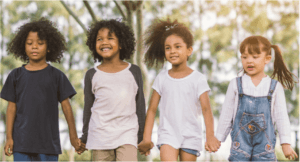Vote for Children’s Environmental Health and Equity
Our children are our most valuable resources, yet their health and that of their families and communities have not been at the forefront of our nation’s policies and programs. Between a global pandemic, the climate crisis, crumbling infrastructure, underfunded public health systems, and long overdue conversations concerning pervasive structural racism, we are faced with interconnected environmental, political, health, and humanitarian issues that affect all of us, but especially our children and that of generations to come. Decisions we make now about how to build back better can improve children’s lives now, which will have cascading positive impacts throughout their lives.
The 2020 elections offer an opportunity to #Vote4Kids and reset our national, state, and local priorities and to put children’s health and their environment at the center of decision-making. The Children’s Environmental Health Network (CEHN) has released a 2020 Voter Guide to help citizens assess their candidates’ commitment to these issues. We need leaders who are willing and able to tackle the intertwined and enduring challenges of wealth inequality, racism, pollution and ecological decline in order to best protect the health of all children.


Children are especially vulnerable to environmental hazards. Their bodies are still developing, so a smaller dose of a pollutant can have a bigger impact than on an adult and can have long-lasting physical and mental impacts on a child’s life course. For instance, childhood lead exposure can damage a child’s brain and nervous system, slow their growth and development, and cause learning and behavior problems and lowered IQ. Another example: elevated levels of ground level ozone can decrease a child’s lung functioning and increase the risk of developing asthma among children who play outdoor sports. Children across the country—and especially children and pregnant women from low income communities, tribal communities, and communities of color—are disproportionately exposed to hazards from natural and built environments, placing them at higher risk for illness and disability. A disregard for environmental health and environmental justice has very real and significant social, economic, and security implications for our nation’s future. And similarly, we need solutions that multi-solve for these compounding factors.
Currently one in four students in the U.S. has a chronic condition, one in five has learning and attention problems, and the number of children receiving Social Security Income for disability is almost seven times larger than it was 30 years ago. Many of the childhood chronic diseases and developmental disabilities that have been increasing significantly over the past 40 years are environmentally mediated, and many are already increasing and intensifying due to our changing climate.


Climate change brings stronger storms, more extreme heat waves, more numerous and intense wildfires, and increased flooding. These effects and others threaten our air and water quality, food security, family and community stability, and our children’s physical and mental health. Climate change can also set the stage for more pandemics, as droughts and extreme temperatures increase our risks of zoonotic diseases. In the case of COVID-19, environmental factors can also influence a patient’s prognosis. Mounting scientific evidence demonstrates that exposure to air pollutants directly affects our ability to survive a virus that attacks our respiratory system, as is common with many emerging zoonotic diseases. Children in low income communities and communities of color are at greatest risk from the effects of climate change due to higher rates of existing health problems and stressors, increased proximity to hazards, and lack of sufficient resources and stability for preparedness and resilience. Climate-related crises thus exacerbate their disproportionate challenges. All children deserve not just resilient communities, but thriving communities. We can and will get there. One way is to exercise our right to vote and to #Vote4Kids.
CEHN’s new voter guide can be used to assess candidates running for office at all levels of government. The guide focuses on five key issues for children’s environmental health:
- Children’s Health and Equity
- Climate Action
- Clean Air
- Clean Water
- Toxic-free Environments and Products
Please use this resource as you go to the polls this fall, and share it widely, especially with those who may not be familiar with children’s environmental health issues. We must unite and stand up for equity, a clean and healthy environment, and for just and urgent climate action for ALL children.
Kristie Trousdale is the Deputy Director and Hannah Grose is the Program Assistant at the Children’s Environmental Health Network (CEHN). CEHN is a partner of Climate for Health, a coalition of health leaders committed to caring for our climate to care for our health. Founded by ecoAmerica, Climate for Health offers tools, resources, and communications to demonstrate visible climate leadership, inspiring and empowering health leaders to speak about, act on and advocate for climate solutions. Learn more about our partnership and the resources available to you here.